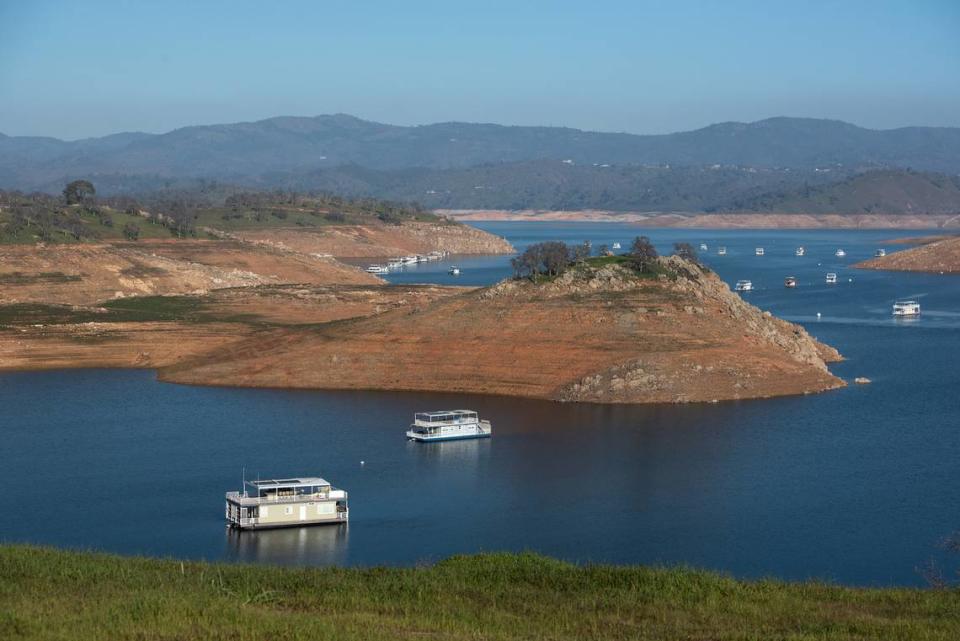How will Modesto and Turlock irrigation districts keep the power on as the climate warms?
This story is part of a Modesto Bee series on climate change impacts for the Stanislaus region.
The weather patterns of climate change are expected to make hydroelectric power less reliable for the Modesto and Turlock irrigation districts.
As anticipated heat waves toast the Northern San Joaquin Valley, air conditioning for homes and office buildings will tax the electrical grid. And there will be less water for pushing the turbines at Don Pedro Dam, a major supplier of electricity for MID and TID.
The districts, serving 231,000 electric service customers, can purchase more energy from plants that burn coal and natural gas. But those energy sources, emitting greenhouse gases, are supposed to be eliminated or mitigated under California’s climate goals.
Martin Caballero, assistant general manager of electric resources for MID, said the district is looking into options for expanding its assortment of energy sources to meet future needs, while reducing the type of emissions that are warming the planet.
Studies show the Sierra Mountains are getting less rain and snow in the fall and spring. It forces water districts to rely on a few extremely wet storms in a shortened winter season — those atmospheric rivers — to meet the needs of agricultural and urban customers.
As this pattern continues in the next few decades, experts say the Sierra runoff in rivers will occur earlier in the spring, fouling up the timing of hydropower generation, which is needed for high demand periods in the summer months.
Longer and drier droughts also serve to stymie hydropower generation. That crucial source of energy in California dropped 48% below a 10-year average during the critically dry year of 2021, according to the U.S. Energy Information Administration.
Caballero said the irrigation districts have not yet seen significant impacts to Don Pedro generation but “we have seen big increases in demand in the last few years.”
In the Northern San Joaquin Valley, studies are predicting the average maximum daily temperatures will increase 4 to 5 degrees by midcentury, with more frequent heat waves of 105 degrees or more.
Caballero said MID’s highest peak electric demand was 700 megawatts in the deadly heat wave of 2006, which was marked by high humidity, 12 consecutive days above 100 degrees and 23 heat-related deaths in Stanislaus County.
The record stood for 16 years and was surpassed in the weeklong scorcher of September 2022, when demand hit 760 megawatts, Caballero said.
MID forecasts its peak demand every five years to assist with California Energy Commission resource planning, and the district expects to be close to 800 megawatts in next year’s updated forecast.
The Modesto district didn’t have projections for electric service rates as climate change impacts the Valley. The California Public Utilities Commission has projected a 40% increase in Pacific Gas & Electric Co. residential rates by 2030 in California as customers try to stay cool.
Caballero said a large increase in energy demand has occurred in the region from California to the Pacific Northwest, probably due to a warming climate and economic growth. The rising demand poses a challenge because it takes time to build new energy resources, he said.
In California, projects to generate tens of thousands of megawatts are proposed or in various stages of development, much of it solar energy and battery storage, the MID official said.
Meeting the state’s climate goals
Water and power utilities have slightly more than 20 years to meet the state’s 2045 goal for carbon neutrality, striking a balance between the carbon emitted and removed from the atmosphere, while also meeting the higher demand for energy to cool homes and businesses and recharge electrical vehicles.
To meet the goals, the state will need around 25 million more electric vehicles, deep cuts to use of fossil fuels and large-scale expansion of wind and solar generation facilities.
Right now, MID generates slightly more than 60% of its retail energy from power plants owned by the district or in partnership with other utilities, while more than 38% is purchased on the open market.
About 18% of MID’s energy supply comes from hydroelectric plants, 16% from wind farms, 14% from solar and 13.6% from natural gas. The energy purchased on the open market isn’t traced to specific sources.
In an ownership agreement with TID, the district receives one-third of the electricity from Don Pedro’s 200 megawatt plant and two-thirds goes to Turlock. MID will get an additional 20 megawatts from Don Pedro after the generating units are refurbished, district officials said.
Hydropower supplies about 20% of the electric service needs for TID, which also draws on wind and solar farms and natural gas plants.

Storing carbon emissions underground
Josh Weimer, a spokesman for TID, said the district will need to layer in other sources of energy under the state’s climate strategy. “Natural gas provides a huge service to the state of California to make sure the power stays on,” Weimer said. “Natural gas and Don Pedro are critical assets to the district. Solar and wind do not produce when the wind is not blowing and the sun is not shining.”
Because of the intermittent nature of wind and solar generation, battery storage systems are deemed essential to the clean energy transition in California.
MID and fellow members of the Balancing Authority of Northern California are considering a carbon sequestration project north of Sacramento that could allow the district to keep using natural gas. People in the environmental community are critical that the state’s climate strategy relies too heavily on capture and storage of carbon emissions from oil production and natural gas instead of eliminating those emissions.
The Modesto district also could invest in more solar; it already has a contract with a 25-megawatt solar energy project and agreements with several other solar facilities throughout the state.

